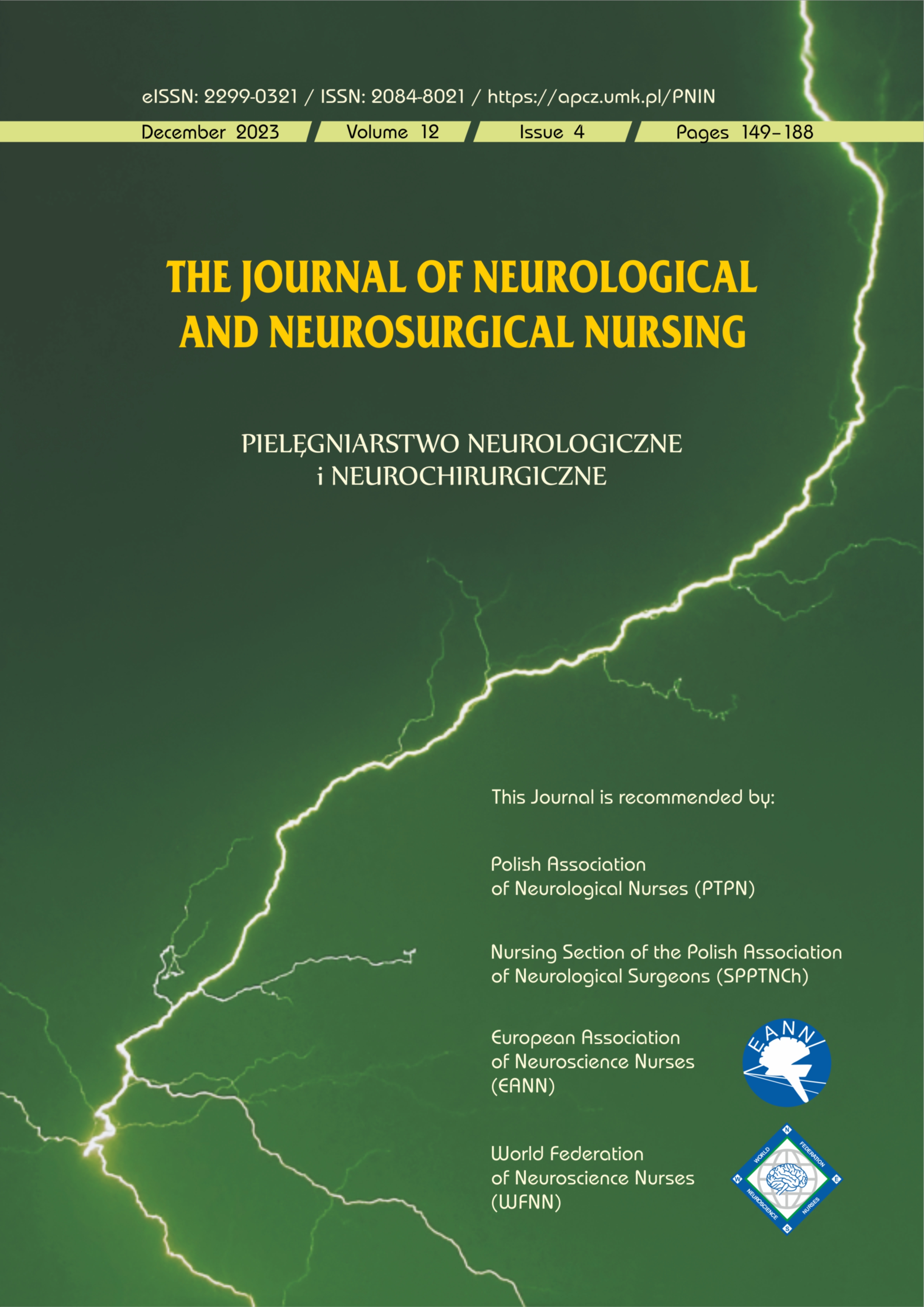Characteristics of the Problems of a Patient with a Pituitary Tumour Treated Endoscopically through the Sphenoid Sinus
DOI:
https://doi.org/10.15225/PNN.2023.12.4.4Keywords
endoscopic procedure, nursing problems, pituitary glandAbstract
Introduction. Pituitary tumours are usually benign adenomas. Surgical treatment is most often dedicated to patients with adenomas that cause symptoms of pressure, such as visual disturbances, headaches or symptoms resulting from hormonal disorders.
Aim. The aim of this study is to present the characteristic problems of a patient with pituitary macroadenoma who underwent endoscopic surgery through the sphenoid sinus.
Case Report. An individual case study of a 42-year-old man with pituitary macroadenoma who underwent surgical treatment through the sphenoid sinus is presented. The patient’s problem before neurosurgical treatment were headaches, which impaired his functioning. The postoperative period was uneventful, but required careful monitoring of the patient for cerebrospinal fluid leakage from the nose, diabetes insipidus and electrolyte disturbances.
Discussion. The case we analyzed required intensified multi-directional observation due to the risk of complications. After surgery, the patient was relatively quickly independent in everyday activities. Additionally, he required further support and education from the nursing team.
Conclusions. Endoscopic procedure through the nose and sphenoid sinus does not externally mutilate the patient, the postoperative wound is moved deep into the nose. The patient remains physically fit, quickly becomes independent in everyday activities, and requires little assistance from the nurse. Furthermore professional nursing observation of the patient after transsphenoidal endoscopic surgery allows detecting disturbing symptoms, enabling their early recognition and effective treatment. (JNNN 2023;12(4):170–176)
References
Budrewicz S., Szymczyk M., Chojdak-Łukasiewicz J., Szewczyk P., Sokolska V. Guzy przysadki — trzy warianty kliniczne; różne konsekwencje terapeutyczne. Pol Przegl Neurol. 2009;5(1):39–44.
Lleva R.R., Inzucchi S.E. Rozpoznawanie i leczenie gruczolaków przysadki mózgowej. Onkologia po Dyplomie. 2011;8(2):57–65.
Esposito D., Olsson D.S., Ragnarsson O., Buchfelder M., Skoglund T., Johannsson G. Non-functioning pituitary adenomas: indications for pituitary surgery and post-surgical management. Pituitary. 2019;22(4):422–434.
Aiyer R.G., Upreti G. Endoscopic Endo-nasal Trans-Sphenoidal Approach for Pituitary Adenomas: A Prospective Study. Indian J Otolaryngol Head Neck Surg. 2020;72(1):36–43.
Zawada N.B., Kunert-Radek J. Klinicznie nieczynne hormonalnie guzy przysadki. Folia Med Lodz. 2012;39(1):87–138.
Messerer M., Cossu G., George M., Daniel R.T. Endoscopic Endonasal Trans-sphenoidal Approach: Minimally Invasive Surgery for Pituitary Adenomas. J Vis Exp. 2018;131:55896.
Ahn S., Park J.S., Kim D.H., Kim S.W., Jeun S.S. Surgical Experience in Prevention of Postoperative CSF Leaks Using Abdominal Fat Grafts in Endoscopic Endonasal Transsphenoidal Surgery for Pituitary Adenomas. J Neurol Surg B Skull Base. 2021;82(5):522–527.
Li B., Zhao S., Fang Q. et al. Risk factors and management associated with postoperative cerebrospinal fluid leak after endoscopic endonasal surgery for pituitary adenoma. Front Surg. 2022;9:973834.
Kozok-Paździor M., Dobosz P., Sobolewska A., Sobański D. Endoskopowa przeznosowa resekcja oponiaka guzka siodła tureckiego — opis przypadku. Pol Prz Otorynolaryngol. 2019;8(4):24–29.
Sanders-Taylor C., Anaizi A., Kosty J., Zimmer L.A., Theodosopoulos P.V. Sellar Reconstruction and Rates of Delayed Cerebrospinal Fluid Leak after Endoscopic Pituitary Surgery. J Neurol Surg B Skull Base. 2015;76(4):281–285.
Xue L., Wu J., Chen J., Yang Y. Change in the pituitary stalk deviation angle after transsphenoidal surgery can predict the development of diabetes insipidus for pituitary adenomas. Endocr Connect. 2022;11(11):e220187.
Brooks E.K., Inder W.J. Disorders of Salt and Water Balance After Pituitary Surgery. J Clin Endocrinol Metab. 2022;108(1):198–208.
Nollen J.M., Brunsveld-Reinders A.H., Peul W.C., van Furth W.R. Patient perspectives on indwelling urinary catheters and fluid balances after transsphenoidal pituitary surgery: a qualitative study. BMJ Open. 2023;13(3):e069598.
Nayak P., Montaser A.S., Hu J., Prevedello D.M., Kirschner L.S., Ghalib L. Predictors of Postoperative Diabetes Insipidus Following Endoscopic Resection of Pituitary Adenomas. J Endocr Soc. 2018;2(9):1010–1019.
Downloads
Published
How to Cite
Issue
Section
License

This work is licensed under a Creative Commons Attribution-NoDerivatives 4.0 International License.
Stats
Number of views and downloads: 429
Number of citations: 0
